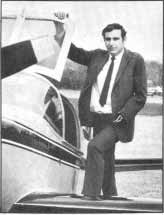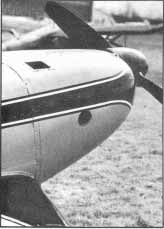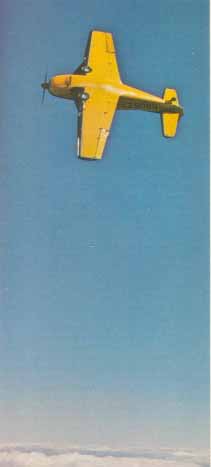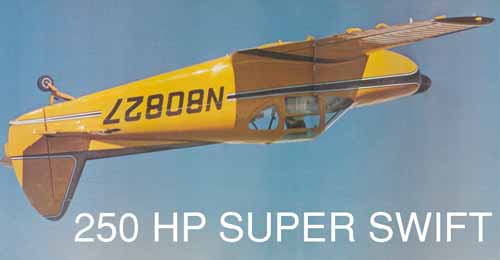When something like this happens," Steve Halpern gestured with
the articulated silver hook that replaced his left hand, "you
have two choices: you can run hide and feel sorry for yourself, or
you can make do with what you have left."
Halpern, who good-naturedly calls himself Captain Hook, was saying
this as we were charging along at 5,000 feet in his mightiest of Swifts.
He punctuated his sentence by twisting into a flawless slow
roll.
 |
Steve Halpern (35 years ago)
didn't start learning to fly until he lost his arm. Gutsy guy!! |
"...I was helping install a new elevator, when a piece of metal
shot across the shaft and hit me. I woke up in the hospital
with my left arm totally useless from the shoulder down. Eventually,
I’d have it amputated. I was damned lucky to be alive and I knew
it. I had a lot of time to think about those things I'd been meaning
to do, but never got around to. Learning to fly was one of them. So,
as soon as I got out of the hospital, I started taking lessons. I think
the ink on my license was still wet when I bought the Swift. Then it
was still a standard 145 hp."
He was referring to the yellow streak we were riding across the sky.
Halpern, of Woodmere, New York, owns and flies what is probably one
of the hottest little airplanes flying today. Outwardly, there is practically
nothing to differentiate it from the standard
Globe Swift. Most people notice the Bonanza wingtips that make it look
like a Bearcat from the bottom, and a few spot the added dorsal fin
and wing root fillets. But practically nobody notices the small round
inlet on the right side of the cowl for the turbocharger or the massive
constant-speed propeller that is necessary to
provide traction for the horsepower factory under the cowling, a 250-hp,
turbocharged Franklin.
This brutish little backyard fighter is usually referred to as a D'Arcy
Swift because the engine conversion and basic airframe beefing was
done by John D'Arcy of Miami, Florida. D'Arcy is one of a whole legion
of Swift nuts who border on being fanatics about modifying
and changing the little airplane. D'Arcy is the most advanced and sophisticated
of the bunch, as he has been competing in aerobatic contests for quite
a few years with hotrodded Swifts.
 |
Only the turbo inlet hints
things are really cookin' under the cowl . |
His modification program was not without its glitches, the most outstanding
being the time he pulled a wing off a stock Swift. He was getting ready
to show the 9G capabilities of the airframe to the FAA and was checking
out a new camera mount when he pulled a bit too hard. He didn't realize
how much extra speed he was getting from the 250 hp Franklin.
He caught a glimpse of the G meter going past 11 and suddenly found
himself outside, dangling in his parachute with pieces of
Swift disappearing in the distance. Because of that little
setback, he has completely re-engineered the Swift and beefed-up all
its weak points, making it an airplane capable of any inside or outside
maneuver the pilot cares to try.
Halpern walked me around his airplane and pointed out some of the structural
changes D'Arcy made. Both the top and bottom centersection spar caps
have been strengthened by massive aluminum bars. The outer wing panel
attach points, which failed in the earlier folding-wing-Swift incident,
have been replaced by gigantic steel fittings running well out into
the panels and each panel has an extra rib besides. All the tail spars
are doubled up to take the beating of multiple snap rolls, and the
rear fuselage bulkhead has been replaced by a heavier one with fewer
cutouts.
Halpern was satisfied with the safety of the beefing program, so he
decided to take off on another program, aimed at speed. The Swift,
for all its sleek lines, is basically a pretty dirty airplane. It needs
fillets here and bends there, and Steve decided to supply them. He
replaced all protruding screws and bolts with flush ones, especially
in the windshield area, adding a quick release canopy while he was
at it. He canted the wing leading edges forward, a la P-51, so the
wheels would be flush when retracted. He plans to add gear doors in
the near future. Because of the speed and weight changes, the airplane
flew with the elevators trimmed constantly down, adding
drag, so he's now in the process of changing the angle of
incidence of the stabilizer, and will remove the vertical
tail offset at the same time. It's already incredibly fast, but how
fast is fast enough?
The Franklin 0-350 engine is actually a fugitive from a helicopter
production line, so it's really a bear for punishment. It gets a lot
of power out of a very few cubic inches, so it doesn't like to run slowly.
It's happiest when screaming and the pressure carburetor in the
inverted system doesn't help when on the ground. To keep it from fouling
up, you have to operate it with the mixture halfway out until almost
ready to take off. It coughs and wheezes and sounds as if it's going
to conk out any second.
 |
Did we say something about
Hook having fun? |
Taxiing out, fiddling with the mixture to keep it running,
I had the occasion to look around. The interior hasn't been
completed yet, but even so I could see it was still basic Swift, 1946.
The gear and flaps are still those archaic-looking barroom
spigots that make you switch hands on the wheel to operate, and the
circuit breakers, which double as electrical switches, are still mounted
in that innocuous whitish, ribbed plastic that reminds me of early
RockOla jukeboxes. Worst of all, the trim is still mounted behind my
head on the turnover structure and made me risk a charliehorse every
time I twisted around to reach it. About the only things that hint
at what's up front are the new vernier throttle, prop control and a
manifold pressure gauge that goes up to 60 inches. That
certainly looks out of place in a Swift!
I guess the thing uppermost in my mind when I started the takeoff was
torque. This was an awfully little airplane and a mighty big engine.
I screwed the throttle vernier slowly in, or at least I thought it
was slowly.
Every turn of the throttle rewarded me with a tremendous increase in
noise and a smack in the small of my back. It accelerated like a full-grown
fighter and when I pushed the nose down, the runway looked as if it
were going by at a fantastic rate. With that big prop blowing so hard
on the rudder, it was effective as soon as the throttle
started moving. Even so, I didn't need all that control because it
tracked straight ahead. I pulled it off the ground and tried to hold
100 mph while the heavy-duty pump sucked the gear up. My climb-out
angle should have left no doubt that this was not the usual ground-hugging
Swift.
I'd watched Steve take off a number of times and I knew that the combination
of prop and exhaust noise was making the gophers dig deeper holes,
so I reduced power until I cleared the pattern and headed out into
the practice area. Even at reduced power, the cockpit noise
was something to be shouted over. Climbing at 80 mph indicated,
I started timing the rate of climb. The altimeter was going around
at least twice as fast as my second hand and we covered
a good 2,200 feet while the hand made one lap of the dial.
GO TO NEXT
PAGE
|

